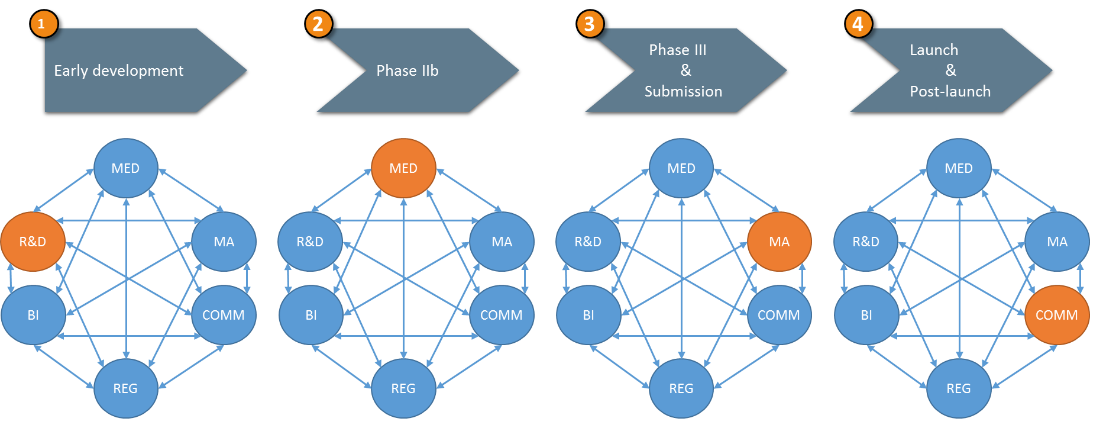Challenges of matrix organization
It is for a good reason that most pharmaceutical companies are structured in a matrix organization. It allows for breaking vertical information silos and establishing a horizontal flow of skills and information, making the organization more effective in brand and project management.
However, as any organizational model, the matrix structure comes with a challenge, as people in the organization have two types of responsibilities: (i) functional (through vertical authority) and (ii) cross-functional (through horizontal alignment). This creates the complexity of having multiple ‘bosses’, often leading to a lack of clarity about goals, roles, processes, priorities or accountability.
To ensure success in the matrix, aligned goals, priorities and strategies are vital to avoid conflicting agendas. In addition, clear responsibilities, processes and an agreed modus operandi for decision-making need to be established. Lastly, the cross functional team should operate as a business, with entrepreneurial spirit and with a culture where real feedback is easily given and taken.
How to overcome the specific matrix challenges for Market Access?
So, how is the Market Access function functioning in this matrix organization? Our observation is that the matrix is even more challenging for Market Access than for other functions. This is because Market Access faces four specific challenges that need to be overcome.
Challenge #1 :
Market Access is often not included fully in the brand team structure from start to end.
Market Access needs to be part of the cross-functional brand teams from early development onwards. First of all because in this way, the team gets a chance of establishing a shared way of working. But more specifically, this is needed for Market Access to align with the Clinical and Health Economics and Outcomes Research functions at an early stage. This enables Market Access to ensure the research program is designed in such a way that a spot-on value dossier can be developed, focusing on the criteria authorities and payers value. This allows faster time to market, at better reimbursement conditions. Furthermore, the Market Access role in the brand team needs to continue during the post-launch phase, since more and more payers demand real-world evidence after granting Market Access.
Challenge #2:
Market Access is often supportive and not fully participating.
In order for Market Access to fully contribute, it should have sufficient resources to optimally participate in brand team meetings. Furthermore, a rotating lead role in the brand teams allows for balancing different goals and priorities in a matrix organization (see figure below).

Challenge #3
Market Access people tend to have a highly technical profile.
Once the functional capabilities, processes and structure allow Market Access to effectively deliver value to the brand teams, we have to ensure the cross-functional capabilities are in place to work together effectively. Technically oriented people typically find it challenging to work together with people with a different expertise. There are good results to be gained with training interpersonal skills to Market Access people:
I. applying a broad perspective beyond your own function;
II. showing proactive leadership and communication skills;
III. engaging others by means of your influencing skills; and
IV. demonstrating personal effectiveness and flexibility.
Challenge #4:
Market Access is often poorly understood by other functions.
Egon Zehnder found in 2015 that less than 10% of the top 15 pharma CEOs has ever spent time in Market Access and 69% of Market Access leaders spent an average of 12 years of their (15-year) careers in a Market Access function. This is one of the reasons that the Market Access function is often poorly understood by other functions. It’s too isolated. Reaching out to the rest of the organization will greatly improve cooperation and results. Small steps already help. For example, by organizing a training in ‘Market Access for non-Market Access functions’.
How do you shape your Market Access function?
Pharmaceutical companies tend to focus on having the Market Access functional expert capabilities in place. But there is so much to be gained in having the right skills and processes in place for increasing the organizational effectiveness. Is your ambition to master the matrix? We have extensive experience with supporting pharma companies dealing with matrix challenges by focusing on both skills and structure. For more information, you can contact Bas Amesz.



